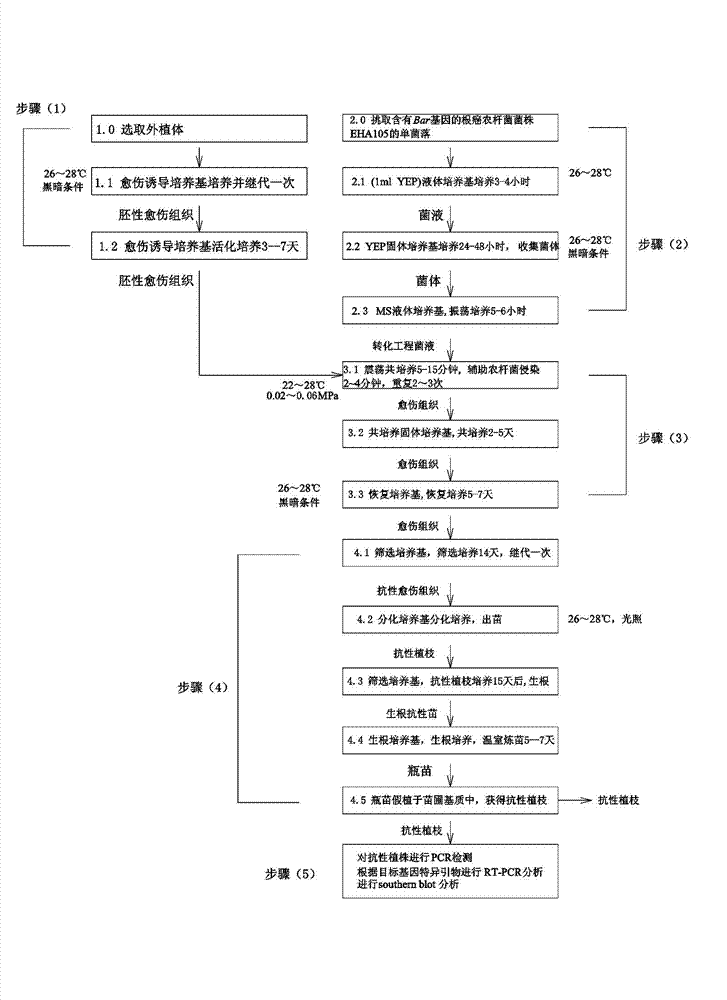Agrobacterium-mediated sugarcane genetic transformation method with vacuum infiltration assistance
An Agrobacterium-mediated, vacuum infiltration technology, applied in the field of plant biology, can solve the problems of reduced transgenic plant quantity, callus growth damage, low genetic efficiency of sugarcane engineering strains, etc., and achieve the effect of improving the genetic transformation rate
- Summary
- Abstract
- Description
- Claims
- Application Information
AI Technical Summary
Problems solved by technology
Method used
Image
Examples
Embodiment 1
[0047] Induction and proliferation of sugarcane heart leaf embryogenic callus in step (1):
[0048] (1.0) The sugarcane variety Yuetang 00-236 was used as the receptor material for transformation. On sunny days, the tip of healthy sugarcane was stripped off the outer leaf sheath, sterilized by 0.1% mercuric chloride solution for 15-20 minutes, and rinsed with sterile water. 3 to 4 times, the young heart leaves of 3 to 5 cm from the top growth point of the sugarcane stem tip were taken as explants for virus-free tissue culture. Under sterile conditions, the explants were cut into disks with a thickness of about 1-2 mm.
[0049] (1.1) Inoculate the explants from step (1.0) on callus induction medium (MS + 2,4-D (2~3) mg / L + 30 g / L sucrose + 8 g / L agar ), and cultured in the dark at 26-28°C for 15 days to obtain embryogenic callus, select light yellow, well-dispersed embryogenic callus for subculture once,
[0050] (1.2) Select light yellow, well-dispersed subcultured embryogen...
Embodiment 2
[0073] Each step of this embodiment is identical with embodiment 1, and the difference between this embodiment and embodiment 1 is:
[0074] Vacuum infiltration in step (3) assisted Agrobacterium infecting sugarcane embryogenic callus:
[0075] (3.1) Take the embryogenic callus that was activated and cultured in step (1.2) for 3 days, place it on the sterile dry filter paper in the ultra-clean workbench, and blow it for about 30 minutes until the surface is dry. Transfer the callus into the Erlenmeyer flask containing the prepared transformation engineering bacteria solution in step (2), co-cultivate for 5 to 15 minutes at 80 rpm, 22~28°C culture conditions; In the container, open the sealing film of the Erlenmeyer flask, give 0.04 Mpa vacuum pressure to assist the Agrobacterium infection for 2 minutes, repeat 3 times;
[0076] (3.2) Transfer the Agrobacterium-infected callus in step (3.1) onto the co-cultivation solid medium (MS + AS 150 μmol / L) covered with filter paper, an...
PUM
 Login to View More
Login to View More Abstract
Description
Claims
Application Information
 Login to View More
Login to View More - R&D
- Intellectual Property
- Life Sciences
- Materials
- Tech Scout
- Unparalleled Data Quality
- Higher Quality Content
- 60% Fewer Hallucinations
Browse by: Latest US Patents, China's latest patents, Technical Efficacy Thesaurus, Application Domain, Technology Topic, Popular Technical Reports.
© 2025 PatSnap. All rights reserved.Legal|Privacy policy|Modern Slavery Act Transparency Statement|Sitemap|About US| Contact US: help@patsnap.com

